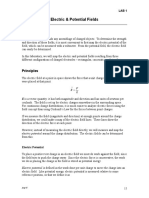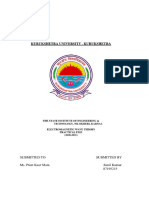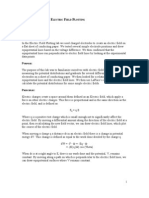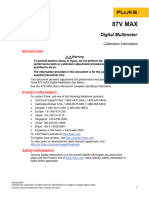Lab 4 Electric Potential
Lab 4 Electric Potential
Uploaded by
Jorge TenorioCopyright:
Available Formats
Lab 4 Electric Potential
Lab 4 Electric Potential
Uploaded by
Jorge TenorioCopyright
Available Formats
Share this document
Did you find this document useful?
Is this content inappropriate?
Copyright:
Available Formats
Lab 4 Electric Potential
Lab 4 Electric Potential
Uploaded by
Jorge TenorioCopyright:
Available Formats
Electric Potential and Electric Field II
Theory It is possible to use Gausss law to determine the electric field due to highly symmetric charge distributions. For a long, straight wire the electric field can be derived:
E= 2 k r r (1)
where k =
and 0 is the permittivity of free space, is the charge per unit length of 4 0 the wire, r is the distance from the center of the wire to the field point, and r gives the direction of the electric field.
The potential difference between two points can be determined if the electric field E between the two points is known:
V = E dl
a
(2)
where the quantity dl represent the path taken between the points a and b. This relationship can be inverted and the components of the electric field can be expressed in terms of derivatives such as
Ex = V x (3)
where denotes a partial derivative. That is, take the derivative but hold all other variables constant except the one you are differentiating with respect to. One arrangement of conductors in this lab will be coaxial rings. The inner ring will have an electric field described by equation (1) which when substituted into equation (2) can be integrated to find the potential difference between the inner ring of radius a and a second point a distance of r from the common center of the two rings:
r V (r ) = 2k ln (4) a It must be noted that the experiment is done with the probes submerged in water so equation (1) and (4) must be modified for the presence of water. Water is a dielectric material (a nonconductor) so we need to replace the permittivity of free space which is part of the constant k by 0 where is the dielectric constant.
For more information see Young and Freedman 22.3-4 and 23.2-5. This lab is a continuation of the previous weeks exercise.
Procedure Part 3: The Dipole Create a set of dipole conductors by using pennies and clamping them to the bottom of the tank with the long conducting braces provided with your equipment. Each connection between brace and penny must be tight. Put the centers of the pennies 12 cm apart, with the tank center halfway between the pennies. Trace six equipotential lines in one half of the tank. WARNING: because of the presence of the glass boundary, these equipotential lines will not look exactly like those of a dipole. When finished tracing the equipotential lines use the two-point probe to measure the electric field (magnitude and direction) at the locations specified on the board. Draw these electric field vectors on your paper. Part 4: Coaxial Rings Remove the pennies and the braces. Use the largest ring and the smallest ring to set up a pair of oppositely-charged coaxial rings; the leads for the signal generator should be connected directly to the rings using alligator clips. Based on the previous experiment, predict whether the cylinders will themselves be equipotentials. Make measurements to test your prediction and discuss the results. If your prediction is incorrect resolve the inconsistency between your prediction and your data. Select the inner ring as your location of zero potential and measure the rms voltage at five different radii (measured from the common axis all five radii should be larger than the radius of the inner ring and smaller than the radius of the outer ring); for each radius r, measure Vrms at angles of both 0 and 180. Enter these measurements in Graphical Analysis, creating the necessary columns to plot Vrms vs. ln(r). Your result should be linear; determine the slope and intercept, with errors, and state your result for Vrms(r) in your conclusions. Use the value of the slope to determine the charge per unit length on the inner ring and its error. Switch to the fixed spacing probe assembly to make measurements of the electric field between the two circles. Measure the electric field every 0.5 cm along two different radii. Record these E values as well as the distances r from the center of the circles (choose the r value at a point exactly in the middle of the probe tips). Represent the measured E values with little vectors on your sketch. Your measurements should start at the location of the inner cylinder Enter the measured E values and corresponding r values in Graphical Analysis. Make a plot of E vs. 1/r, making use of the calculated column option as needed. Use the slope of the straight-line relationship to make determination of the charge per unit length of the inner ring and its error. Measure the E-field outside the outermost cylinder. Is this result consistent with Gausss law?
Please note with the alternating current the charge per unit length is really varying in a sinusoidal fashion with a period of about 5 ms. Since you are measuring the rms voltage and E-field you are really determining the rms charge per unit length of the inner ring. To make this estimate, you must assume that the two cylinders are infinitely long. This assumption is not absurd because the space between the rings is filled with water, which is a reasonably good conductor, and because we are using AC. For either direction of the alternating current, charges quickly gather on the upper and lower surfaces of the water until the field in the water is purely radial, and radially symmetric, as it would be for infinitely long conductors.
Hints and Notes Remember to attach your drawings of the equipotentials for the dipole and the coaxial rings. Also include the plots of Vrms vs. ln(r) and E vs. 1/r. In addition to the questions asked above you should discuss your answers to the questions below. For the coaxial rings: From your data, what will be the shape of the equipotentials? Take additional readings if you are not sure. Is the fact that E is proportional to 1/r consistent with the linear dependence of the electric potential on ln(r)? Explain. Are your calculated values for , the charge per unit length, consistent with each other? For both parts: Is the electric field perpendicular or parallel to the equipotential lines you have drawn? In this experiment (and last weeks) you used two measuring probes. The single lead probe was used to measure the rms voltages and the two point probe was used to determine the electric field. Explain why the two-point probe is needed to measure the electric field.
Prelab for Electric Potential and Electric Field II Name:_________________________ Section day/time___________________
1. (10 points) From the potential map shown below estimate the electric field E at the point (x,y) = (2 mm, 1 mm). Draw the E vector on the map, and give Ex and Ey. The outer three equipotentials are labeled; the potential continues to increase by 2 V per equipotential as the radius of the equipotentials decreases.
You might also like
- Equipotential MappingDocument6 pagesEquipotential MappingSaritech100% (4)
- Manual PowerFlex 753Document438 pagesManual PowerFlex 753maikonrangel75% (12)
- Electro Pot PDFDocument3 pagesElectro Pot PDFdanteNo ratings yet
- Lab 3 Electric FieldsDocument3 pagesLab 3 Electric Fieldseagle9333No ratings yet
- Physics 2 Lab ManualDocument118 pagesPhysics 2 Lab ManualAl Anood Al AmeriNo ratings yet
- Experiment 2 Electric Potential and Field Mapping: Florida Institute of Technology © 2020 by J. GeringDocument8 pagesExperiment 2 Electric Potential and Field Mapping: Florida Institute of Technology © 2020 by J. GeringHafizSikandarNo ratings yet
- LR2 Electric Field Plotting Part IDocument5 pagesLR2 Electric Field Plotting Part IabeermousaNo ratings yet
- Electric & Potential Fields: PurposeDocument14 pagesElectric & Potential Fields: PurposeEdd BloomNo ratings yet
- What Is PotentiometerDocument19 pagesWhat Is PotentiometerVishvajeet PalNo ratings yet
- Physics Lab Manual XII 2021-22Document20 pagesPhysics Lab Manual XII 2021-22kangan nagiNo ratings yet
- Em RatioDocument5 pagesEm RatioKaran SinglaNo ratings yet
- A - Phys102 - Lab 1 - Coulomb's LawDocument16 pagesA - Phys102 - Lab 1 - Coulomb's Lawtriley89No ratings yet
- Equipotential Lines-1Document3 pagesEquipotential Lines-1hassantamer2005a1No ratings yet
- Experiment 6 Electric Field Mapping: ObjectiveDocument5 pagesExperiment 6 Electric Field Mapping: ObjectiveKapil Hariom ParetaNo ratings yet
- Equipotential Mapping: ObjectivesDocument4 pagesEquipotential Mapping: ObjectivesjblancopiconNo ratings yet
- Electric Fields and Potentials1Document9 pagesElectric Fields and Potentials1dianaNo ratings yet
- PhysicsDocument7 pagesPhysicssakchhampradhanangNo ratings yet
- Physics Practicals Experiment: PotentiometerDocument14 pagesPhysics Practicals Experiment: PotentiometerdeoNo ratings yet
- Lab 28Document6 pagesLab 28George ChandlerNo ratings yet
- 4 Current Electricity Theory (Part 4)Document11 pages4 Current Electricity Theory (Part 4)Ronda StewartNo ratings yet
- Lab 3 Electric Fields and Potentials f14Document3 pagesLab 3 Electric Fields and Potentials f14projectapply2023No ratings yet
- XII Physics Practical 2020 21Document39 pagesXII Physics Practical 2020 21HITEN SOLANKINo ratings yet
- EM RatioDocument6 pagesEM Ratiocccc gggg oooNo ratings yet
- Family Circle, Jan 2011Document5 pagesFamily Circle, Jan 2011emediageNo ratings yet
- Cun General Physics Practical 2 2024Document17 pagesCun General Physics Practical 2 2024odeinanyanwuNo ratings yet
- Lab 2 - Electric FieldDocument5 pagesLab 2 - Electric FieldAbdoul BinJimNo ratings yet
- Physics Practical ReadingsDocument49 pagesPhysics Practical ReadingsKaran KumarNo ratings yet
- Emw PracticalDocument14 pagesEmw PracticalsourabhNo ratings yet
- NameDocument4 pagesNamemira.120230131No ratings yet
- Phy Lab Manual Class-121Document31 pagesPhy Lab Manual Class-121PAVITHRAN PadmanabhanNo ratings yet
- Physics Lab Exp 1Document4 pagesPhysics Lab Exp 1Shaira EstrellaNo ratings yet
- Electric Fields PDFDocument3 pagesElectric Fields PDFVõ Quốc CườngNo ratings yet
- Mapping The Electrostatic Potential and Electric FieldDocument5 pagesMapping The Electrostatic Potential and Electric Fieldmende5100% (1)
- 206 E3 Lab ReportDocument3 pages206 E3 Lab ReportJustin KanNo ratings yet
- Physics 370 Final Exam Solution Hints Spring Semester 2012 (Study Guide Version)Document13 pagesPhysics 370 Final Exam Solution Hints Spring Semester 2012 (Study Guide Version)Χρίστος ΠαπαναστασίουNo ratings yet
- Phy PotentiometerDocument20 pagesPhy PotentiometerDanyRaj100% (3)
- Lab2 ElectricpotentialandelectricfieldsDocument3 pagesLab2 ElectricpotentialandelectricfieldsClyde MedinaNo ratings yet
- Energy Bandgap of Semiconductor PDFDocument4 pagesEnergy Bandgap of Semiconductor PDFanon_838143593No ratings yet
- 325C2 2005Document5 pages325C2 2005Iven GaneshaNo ratings yet
- G12 Physics Experiment 23-24Document43 pagesG12 Physics Experiment 23-24anonymous3256tNo ratings yet
- Lecture 06Document39 pagesLecture 06همام التريكيNo ratings yet
- Lab 08 - Capacitors and InductorsDocument9 pagesLab 08 - Capacitors and InductorsAlinush AlinutsaNo ratings yet
- To Determine The Internal Resistance of A Cell by A PotentiometerDocument12 pagesTo Determine The Internal Resistance of A Cell by A PotentiometerAkshay PabbathiNo ratings yet
- Physics Record Book 2023 24Document62 pagesPhysics Record Book 2023 24easedaeNo ratings yet
- Physics Practical'sDocument43 pagesPhysics Practical'sTvara PatelNo ratings yet
- Em LabDocument12 pagesEm LabmzmohamedarifNo ratings yet
- PresentationDocument35 pagesPresentationApoorva SharmaNo ratings yet
- XII PHYSICS Summer Vacation Homework PDFDocument3 pagesXII PHYSICS Summer Vacation Homework PDFSoniyaNo ratings yet
- CBSE Class 12 Physics Important Questions-ElectrostaticsDocument11 pagesCBSE Class 12 Physics Important Questions-Electrostaticsaryansalvi0502No ratings yet
- 2021-22 Phy Lab Manual Class 12Document31 pages2021-22 Phy Lab Manual Class 12AartibNo ratings yet
- Lab 7 Magnetic Forces On Charged ParticlesDocument3 pagesLab 7 Magnetic Forces On Charged ParticlesNguyễn Thiên PhúNo ratings yet
- Electric Potential and Electric Field Plotting IIDocument4 pagesElectric Potential and Electric Field Plotting IINate RodriquezNo ratings yet
- Physics Lab Manual - eDocument30 pagesPhysics Lab Manual - eMurukeshwari S SaravananNo ratings yet
- Q3 M3 Electric PotentialDocument5 pagesQ3 M3 Electric PotentialramirezshaniajaneNo ratings yet
- Electrical Measurement Lab (EEE-352)Document23 pagesElectrical Measurement Lab (EEE-352)DhinakarrajNo ratings yet
- Lab 2Document3 pagesLab 2nas4243No ratings yet
- Rayto 1904 Manual InstructionsDocument39 pagesRayto 1904 Manual InstructionsHenry Kaunang60% (5)
- Product Datasheet: Acti9 iC60H 3P 63A C Miniature Circuit BreakerDocument2 pagesProduct Datasheet: Acti9 iC60H 3P 63A C Miniature Circuit BreakerRaphael HoNo ratings yet
- Ac GeneratorDocument2 pagesAc Generatoryashwanth.s10aNo ratings yet
- CG LUCY ETC Medium Voltage Switchgear ProductsDocument32 pagesCG LUCY ETC Medium Voltage Switchgear Productsbinesh_shahenggco100% (3)
- INVT - XG 50-70kW User Manual V1 - 0Document39 pagesINVT - XG 50-70kW User Manual V1 - 0xvd42410No ratings yet
- GE Power Management: Microprocessor Based Generator Protection RelayDocument64 pagesGE Power Management: Microprocessor Based Generator Protection Relayalex pardoNo ratings yet
- Power System Contingency Analysis: A Study of Nigeria's 330KV Transmission GridDocument10 pagesPower System Contingency Analysis: A Study of Nigeria's 330KV Transmission GridEngidaw Abel HailuNo ratings yet
- Unit-4 Single Phase Transformer - NewDocument50 pagesUnit-4 Single Phase Transformer - NewSneha GadgilNo ratings yet
- Elr Elrc 1 BrochureDocument2 pagesElr Elrc 1 Brochurerochmad eko suyudiNo ratings yet
- Laboratory Setup For Variable Speed Control of A Three Phase Ac Induction Motor Using A DSP ControllerDocument6 pagesLaboratory Setup For Variable Speed Control of A Three Phase Ac Induction Motor Using A DSP ControllerAbd Ur RehmanNo ratings yet
- PVS 60-TL Us Inversor PDFDocument4 pagesPVS 60-TL Us Inversor PDFJair SaavedraNo ratings yet
- P10eai src2cDocument1,168 pagesP10eai src2cwillianalvespereira1988No ratings yet
- Dbe 420 Digitax Brushless Ac Servo Drive Control Techniques ManualDocument96 pagesDbe 420 Digitax Brushless Ac Servo Drive Control Techniques ManualJesus Emmanuel Estrada100% (1)
- Mead Isonic Mod 3 (WWW - Mead.co - Uk)Document6 pagesMead Isonic Mod 3 (WWW - Mead.co - Uk)Mead Engineering Services LtdNo ratings yet
- Zelio Relay - Electromechanical - RXM4AB1F7Document6 pagesZelio Relay - Electromechanical - RXM4AB1F7Diego SotoNo ratings yet
- GSM and GPS Based Vehicle Tracking System FRDocument40 pagesGSM and GPS Based Vehicle Tracking System FRDhruvPatel100% (1)
- E Project09 FullDocument137 pagesE Project09 Fullરામ પ્રતાપNo ratings yet
- Quiz No. 2.2: InstructionsDocument20 pagesQuiz No. 2.2: Instructionsjaja caburnay100% (1)
- 3000X-4000X (G4) (机箱式) 单模块连续光纤激光器说明书(英文)V1.7Document47 pages3000X-4000X (G4) (机箱式) 单模块连续光纤激光器说明书(英文)V1.7paralaserNo ratings yet
- Akpc551 080g0281 Quick EnglishDocument6 pagesAkpc551 080g0281 Quick EnglishtahlokoNo ratings yet
- Bus BArDocument822 pagesBus BArCHANDER SINGH WARKADE100% (1)
- Dispenser User ManualDocument80 pagesDispenser User ManualsureshNo ratings yet
- Hawk-I1 Infusion Pump User Manual Ver2.01-2019 (COL)Document81 pagesHawk-I1 Infusion Pump User Manual Ver2.01-2019 (COL)gustavo pestana herreraNo ratings yet
- Catalog Produk LarkinDocument30 pagesCatalog Produk Larkinkiki widyaNo ratings yet
- 87VMAX Cieng0000Document26 pages87VMAX Cieng0000Jesse GarciaNo ratings yet
- DMP Installation ManualDocument36 pagesDMP Installation ManualsethivasonNo ratings yet
- A Synopsis On High Voltage Testing of Transformers: Adnan Iqbal M. Tech (T16EE015)Document14 pagesA Synopsis On High Voltage Testing of Transformers: Adnan Iqbal M. Tech (T16EE015)AdnanNo ratings yet
- 3VL3725 1DC36 0aa0 PDFDocument4 pages3VL3725 1DC36 0aa0 PDFkarian32000No ratings yet
























































































